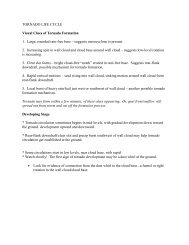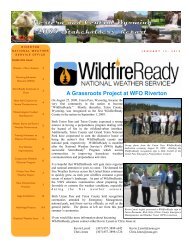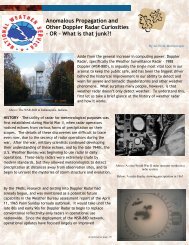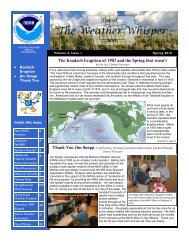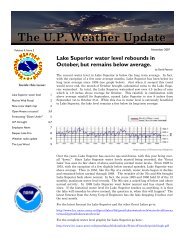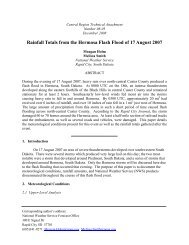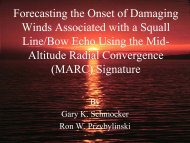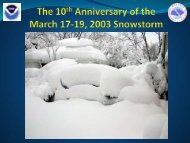Extended Abstract - AMS supported meetings
Extended Abstract - AMS supported meetings
Extended Abstract - AMS supported meetings
Create successful ePaper yourself
Turn your PDF publications into a flip-book with our unique Google optimized e-Paper software.
Figure 1. Topographic map of Colorado. Mountain<br />
ranges and place names discussed in text are shown.<br />
Elevation in kFt.<br />
The least amount of CG activity over the<br />
Centennial State is found over the San Luis Valley.<br />
This large broad valley, with an average elevation of<br />
around 2.3 km (7500 ft), is surrounded on 3 sides by<br />
the San Juan Mountain range to the west and<br />
northwest, and the Sangre De Cristo Mountains to the<br />
northeast and east. The lack of lightning activity in this<br />
valley is due primarily to the lack of low level moisture<br />
due to the blocking of the surrounding mountain<br />
ranges. Not surprisingly, the San Luis Valley is also<br />
one of the driest locations in the state of Colorado.<br />
Another noticeable minimum, this time on the<br />
plains, lies in an area bounded by Denver, to Ft<br />
Collins, to Greeley and back to Denver. This minimum<br />
in activity is likely due to a well known meteorological<br />
phenomenon called the Denver Convergence Vorticity<br />
Zone (DCVZ) which forms when synoptic low level<br />
southeasterly flow forms over the plains of Colorado.<br />
This convergence zone typically extends from roughly<br />
Denver to Greeley, and is a favored initiation area for<br />
thunderstorms (See Szoke et al, 2006 this volume).<br />
Once storms develop along this convergence zone,<br />
the prevailing flow carries the convection off in a<br />
general easterly direction. This in turn leaves a void in<br />
CG activity back to the west of the convergence zone.<br />
Although the circulation of the DCVZ leaves a<br />
minimum in CG activity north of Denver, it likely<br />
enhances the lightning activity south of the Denver.<br />
Surface flow to the west of the DCVZ is from a<br />
northerly component. This northerly flow passes the<br />
Denver area and then begins to go upslope over the<br />
north facing side of the Palmer Divide/Pikes Peak<br />
region.<br />
As mentioned in section 3, three areas of higher<br />
terrain extend east-west across the eastern plains;<br />
Figure 2. The mean annual flash density for the State of<br />
Colorado. Nearly 7 million flashes, from 1989 through<br />
2005 (excluding 2000), were processed to produce this<br />
map. No correction for detection efficiency has been<br />
applied.<br />
the Raton Mesa, the Palmer Divide and the Cheyenne<br />
Ridge. From the above discussion, we know that the<br />
Palmer Divide and Raton Mesa are lightning hotspots,<br />
but the Cheyenne Ridge has noticeably less lightning<br />
activity. There are possibly 3 reasons for this. First,<br />
the elevation of the Cheyenne Ridge is not as high as<br />
the other two ridges. Second, less moisture reaches<br />
this region as compared to the other ridges. We<br />
believe this is due to less monsoon moisture reaching<br />
the northern parts of the State (Fig 3). Third, the<br />
circulation of the DCVZ may play a role in the lesser<br />
amount of CG activity over the southern sections of<br />
the Cheyenne Ridge. It should be noted that, although<br />
not shown, there is not a maximum of lightning activity<br />
on the north side of the Cheyenne Ridge in Wyoming.<br />
Of all of the interior mountains (mountains not<br />
adjacent to the plains) in Colorado, the broad San<br />
Juan range shows the most CG activity. This<br />
maximum is believed to be caused by low to mid level<br />
moisture advecting in from Mexico associated with the<br />
Summer Southwest Monsoon (Watson et. al. 1993).<br />
Over Western Colorado, a minimum in lightning<br />
activity can be seen along the major river valleys,<br />
including the Colorado and Gunnison River Valleys. A<br />
minimum in CG activity is also noted across<br />
Northwest Colorado, and extreme Southwest<br />
Colorado.<br />
One of the highest mountain ranges in Colorado,<br />
the Sawatch Range, has the least amount of CG<br />
activity. This range, located in the center of the State,<br />
has numerous 4.0 – 4.3 km (13 - 14 kft) mountains<br />
along its’ flank. The minimum in CG activity over




